|
|
The Holy Martyrs Julian and Vasilissa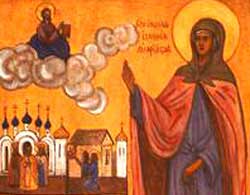 They were both of rich and noble families and, though married, agreed to live in celibacy as brother and sister. They gave their goods to the poor and embraced the monastic state; Julian founding a men's monastery of about 10,000 monks and Vasilissa one for about a thousand nuns. When a violent persecution of Christians was launched under Diocletian, Vasilissa besought God that none of her nuns should suffer torture nor repudiate the Orthodox faith. The Lord hearkened to the petition of His worthy servant and, during the next six months, took all the nuns to Himself, one by one, and finally their abbess Vasilissa. Before her own death, Vasilissa had a vision of her sisters in the other world. They were all bathed in light and were rejoicing like the angels. They appealed to their spiritual mother to join them as quickly as possible.
Julian's monastery was burned by fire, and Julian was inhumanely tortured, being killed only after the most horrible sufferings. The Lord inspired and strengthened him in his torments and he endured them with heroism, keeping faith and glorifying the name of Christ. Together with Julian were beheaded the son and wife of the persecutor Marcian, Celsus and Maronilla, who, seeing Julian's heroic and patient sufferings, were themselves converted to Christianity. Also martyred with him were twenty Roman soldiers, seven brothers from that locality, a priest named Antony and a man called Anastasius whom Julian, at the time of his own martyrdom, raised from the dead by his prayers. They all suffered with honour for Christ and became citizens of the Kingdom of heaven in about the year 313. They were both of rich and noble families and, though married, agreed to live in celibacy as brother and sister. They gave their goods to the poor and embraced the monastic state; Julian founding a men's monastery of about 10,000 monks and Vasilissa one for about a thousand nuns. When a violent persecution of Christians was launched under Diocletian, Vasilissa besought God that none of her nuns should suffer torture nor repudiate the Orthodox faith. The Lord hearkened to the petition of His worthy servant and, during the next six months, took all the nuns to Himself, one by one, and finally their abbess Vasilissa. Before her own death, Vasilissa had a vision of her sisters in the other world. They were all bathed in light and were rejoicing like the angels. They appealed to their spiritual mother to join them as quickly as possible.
Julian's monastery was burned by fire, and Julian was inhumanely tortured, being killed only after the most horrible sufferings. The Lord inspired and strengthened him in his torments and he endured them with heroism, keeping faith and glorifying the name of Christ. Together with Julian were beheaded the son and wife of the persecutor Marcian, Celsus and Maronilla, who, seeing Julian's heroic and patient sufferings, were themselves converted to Christianity. Also martyred with him were twenty Roman soldiers, seven brothers from that locality, a priest named Antony and a man called Anastasius whom Julian, at the time of his own martyrdom, raised from the dead by his prayers. They all suffered with honour for Christ and became citizens of the Kingdom of heaven in about the year 313.Our Holy Father George the Chozebite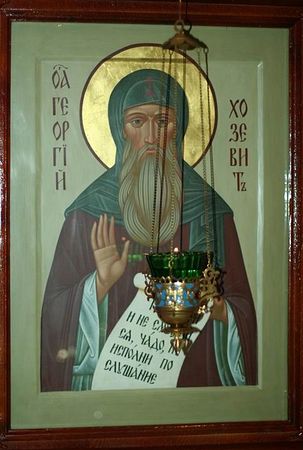 He lived the ascetic life in the seventh century in the Chozebite community on the road from Jerusalem to Jericho, where our holy Father John the Chozebite first lived as a monk. He lived the ascetic life in the seventh century in the Chozebite community on the road from Jerusalem to Jericho, where our holy Father John the Chozebite first lived as a monk.St Domnica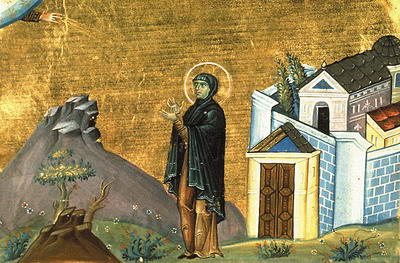 A pagan, she came from Carthage in the reign of the Emperor Theodosius to Patriarch Macarius, accompanied by four girls who were likewise ignorant of God. He baptised them and blessed them to live as nuns. St Domnica devoted herself to asceticism with whole-hearted zeal, and did not falter in that zeal right up to the time of her death at a great age. She entered into rest in about the year 474. By the illumination of the Holy Spirit, she was able to predict the future and perform miracles through prayer. A pagan, she came from Carthage in the reign of the Emperor Theodosius to Patriarch Macarius, accompanied by four girls who were likewise ignorant of God. He baptised them and blessed them to live as nuns. St Domnica devoted herself to asceticism with whole-hearted zeal, and did not falter in that zeal right up to the time of her death at a great age. She entered into rest in about the year 474. By the illumination of the Holy Spirit, she was able to predict the future and perform miracles through prayer.St Gregory, Bishop of OchridA pious teacher and pastor of Christ's flock, he entered into rest in the year 1012. On an inscription in the Church of St Sophia in Ochrid, he is called 'Gregory the Wise'.
Venerable Gregory the Wonderworker of the Kiev Near Caves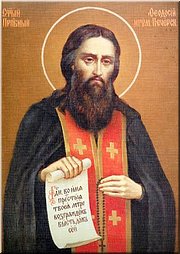 Saint Gregory was tonsured at the Kiev Caves monastery in the time of St Theodosius (May 3). The saint devoted much time to reading books, which were his sole possession. He had the ability to bring thieves to their senses. Several times robbers broke in on him in his cell or in the garden, but the saint reasoned with them, the thieves repented, and began to lead honest lives.
Once, when the monk went to the Dnieper River for water, some servants of Prince Rostislav caught sight of the Elder and rudely began making fun of him. The saint answered them, “Children, when you should be asking for everyone’s prayers, you are displeasing God. Weep, for disaster approaches. Repent and ask God to be merciful to you on the Day of Judgment. All you will find death in the water with your prince.” By orders of the enraged Prince Rostislav, the monk was bound hand and foot, and he was drowned in the Dnieper with a stone around his neck. Still, his prediction came true. Rostislav did not return from the campaign. In that same year of 1093 the twenty-year-old prince drowned in sight of his brother, Vladimir Monomakh, trying to save himself as he fled from the Polovetsians.
Several sources identify St Gregory with St Gregory, a composer of Canons in honor of the holy Prince Vladimir, St Theodosius, and the holy Martyrs Boris and Gleb. But St Gregory, compiler of canons, lived later and died in about the year 1120. St Gregory the Wonderworker died in 1093 and was buried in the Near Caves. His memory is celebrated also on September 28 and on the second Sunday of Great Lent. Saint Gregory was tonsured at the Kiev Caves monastery in the time of St Theodosius (May 3). The saint devoted much time to reading books, which were his sole possession. He had the ability to bring thieves to their senses. Several times robbers broke in on him in his cell or in the garden, but the saint reasoned with them, the thieves repented, and began to lead honest lives.
Once, when the monk went to the Dnieper River for water, some servants of Prince Rostislav caught sight of the Elder and rudely began making fun of him. The saint answered them, “Children, when you should be asking for everyone’s prayers, you are displeasing God. Weep, for disaster approaches. Repent and ask God to be merciful to you on the Day of Judgment. All you will find death in the water with your prince.” By orders of the enraged Prince Rostislav, the monk was bound hand and foot, and he was drowned in the Dnieper with a stone around his neck. Still, his prediction came true. Rostislav did not return from the campaign. In that same year of 1093 the twenty-year-old prince drowned in sight of his brother, Vladimir Monomakh, trying to save himself as he fled from the Polovetsians.
Several sources identify St Gregory with St Gregory, a composer of Canons in honor of the holy Prince Vladimir, St Theodosius, and the holy Martyrs Boris and Gleb. But St Gregory, compiler of canons, lived later and died in about the year 1120. St Gregory the Wonderworker died in 1093 and was buried in the Near Caves. His memory is celebrated also on September 28 and on the second Sunday of Great Lent. St Emilian the Confessor, Bishop of Cyzicus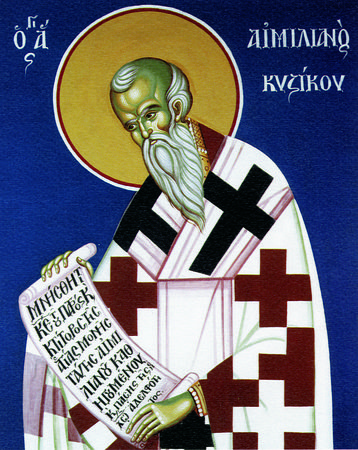 Saint Emilian was a zealous defender of the holy icons during the reign of Emperor Leo the Armenian. He suffered torture and martyrdom in the year 820. His main feast is August 8. Saint Emilian was a zealous defender of the holy icons during the reign of Emperor Leo the Armenian. He suffered torture and martyrdom in the year 820. His main feast is August 8. St Carterius of Caesarea in Cappadocia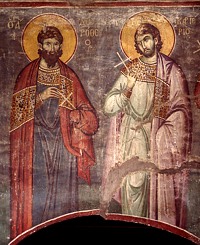 Saint Carterius lived during the reign of Diocletian, and was a teacher in Caesarea of Cappadocia. He stood before a statue of Serapis and prayed to Christ, and the idol shattered to pieces. The procurator Urbanus ordered St Carterius to be tortured and then beheaded. Some, however, say he was killed with a spear. Saint Carterius lived during the reign of Diocletian, and was a teacher in Caesarea of Cappadocia. He stood before a statue of Serapis and prayed to Christ, and the idol shattered to pieces. The procurator Urbanus ordered St Carterius to be tortured and then beheaded. Some, however, say he was killed with a spear. Martyr Theophilus the Deacon, in Libya Saint Theophilus the deacon suffered with St Helladius. After confessing Christ before the governor of Libya, they were tortured and slain. Saint Theophilus the deacon suffered with St Helladius. After confessing Christ before the governor of Libya, they were tortured and slain. Venerable Elias the Hermit, of Egypt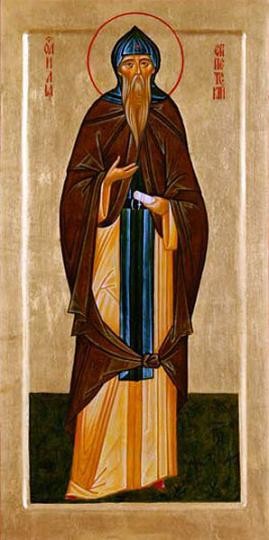 Saint Elias the Egyptian became a monk and pursued asceticism for seventy-five years on a desolate mountain in a cave. He died in the fourth century at the age of 110. Saint Elias the Egyptian became a monk and pursued asceticism for seventy-five years on a desolate mountain in a cave. He died in the fourth century at the age of 110. Martyrs Marcionilla and her son Celsus, Anthony, Anastasius, seven children, and twenty soldiers, at Antinoe in Egypt The Holy Martyr Julian was born in the Egyptian city of Antinoe, and to satisfy his parents he entered into marriage with the nobleborn and rich maiden, Basilissa. In marriage the spouses remained virginal. Upon the death of their parents they built two monasteries: a men's and a women's, and they themselves accepted monasticism and headed these monasteries. In the year 313, during the reign of Diocletian, Saint Julian suffered cruelly for his faith in Christ. But by his bravery he converted Celsius, the son of his torturer the hegemon Marcian, and also that one's wife, Marionilla. Having resurrected a dead pagan, the saint converted him also. The converts received Baptism from Presbyter Anthony. In Baptism the pagan was given the name Anastasias (i.e. "Resurrected"). After imprisonment they all accept a martyr's crown, won through beheading by the sword. With them also were numbered 20 soldiers and 7 youths.
St. Cyrus, patriarch of ConstantinopleSt. Cyrus, Patriarch of Constantinople, died in 714. His memory is kept in the countryside Chorus Monastery.
St. Atticus patriarch of Constantinople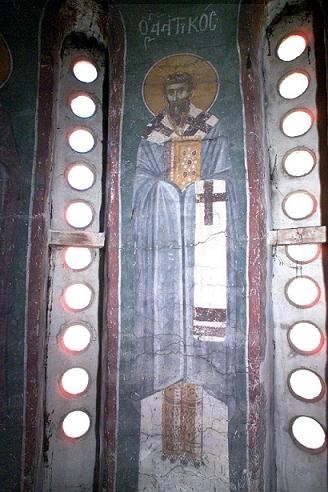 Born in Sebaste in Armenia, he was reared by monks who held to the heresy of Macedonius, which denied the uncreated divinity of the Holy Spirit; but when he came of age he rejected this error and embraced the Orthodox faith. He settled in Constantinople and became a priest in the Great Church. Though he had little formal education, his amazing memory, his zeal for Christ, and his powerful sermons recommended him to all, and he was elected Patriarch in 406, during the reign of the Emperor Arcadius. He served as shepherd to the Church for twenty years, ruling always with wisdom and moderation. Though he was unbending in upholding the Faith exactly, he took a conciliatory, persuasive approach to heretics and schismatics; in this way he was able to restore many to the Church rather than driving them away. His best-known single act is his restoration of the name of St John Chrysostom to the diptychs. Saint John had been unjustly denied commemoration in the Patriarchate since his exile, which had led to a schism; restoration of his commemoration not only corrected a grave injustice but healed a schism. Saint Atticus also presided over the rededication of the Agia Sophia, which had been burned in 404 in the rioting that followed St John Chrysostom's exile. He reposed in peace in 425. Born in Sebaste in Armenia, he was reared by monks who held to the heresy of Macedonius, which denied the uncreated divinity of the Holy Spirit; but when he came of age he rejected this error and embraced the Orthodox faith. He settled in Constantinople and became a priest in the Great Church. Though he had little formal education, his amazing memory, his zeal for Christ, and his powerful sermons recommended him to all, and he was elected Patriarch in 406, during the reign of the Emperor Arcadius. He served as shepherd to the Church for twenty years, ruling always with wisdom and moderation. Though he was unbending in upholding the Faith exactly, he took a conciliatory, persuasive approach to heretics and schismatics; in this way he was able to restore many to the Church rather than driving them away. His best-known single act is his restoration of the name of St John Chrysostom to the diptychs. Saint John had been unjustly denied commemoration in the Patriarchate since his exile, which had led to a schism; restoration of his commemoration not only corrected a grave injustice but healed a schism. Saint Atticus also presided over the rededication of the Agia Sophia, which had been burned in 404 in the rioting that followed St John Chrysostom's exile. He reposed in peace in 425. Venerable Agatho of EgyptSt. Agatho practiced asceticism in Egypt in the 4th Century and died in peace.
Martyr Abo the Perfumer, of Tibilisi, Georgia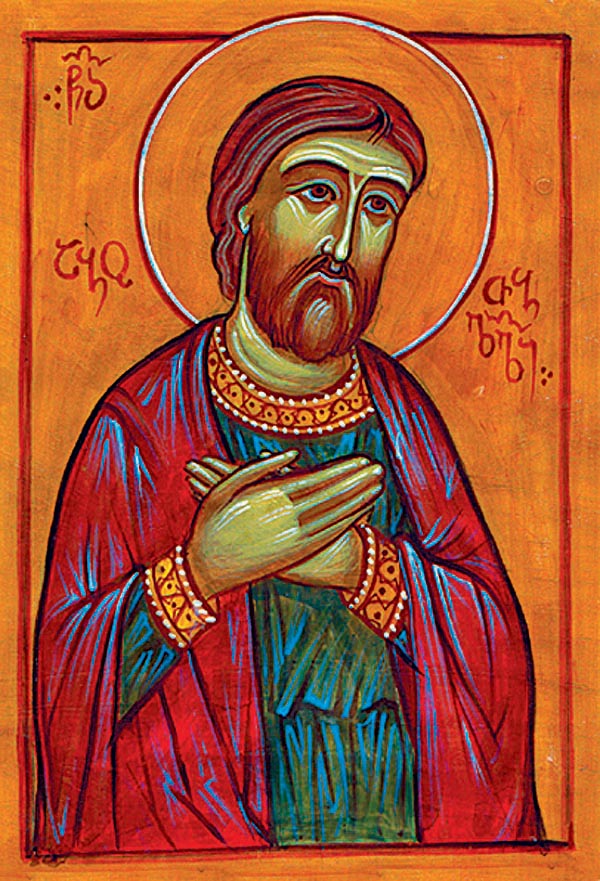 In the 8th century a Saracen army tyrannized Kartli as a first step towards overturning the Georgian nation. The invaders were certain that the best way to conquer Georgia was to uproot the Christian Faith. The Georgian people were alarmed, and the clergy and the best sons of Kartli sought desperately for a resolution to this calamity. Much blood was shed in 766 when theMuslim invaders crushed an uprising in the eastern region of Kakheti.
In 772, Caliph Al Mansur (754-775), dissatisfied with the provincial governor of Kartli, Duke Nerse, summoned him to Baghdad. Nerse spent the following three years in captivity. During that time he became acquainted with a seventeen-year-old perfumer named Abo, and when he was released he brought Abo back with him to Georgia. Abo was amazed at the great piety of the Georgian people, and he began to learn the Georgian language, attend the divine services, and speak with local priests. Abo sought with all his heart to become a Christian, and he was eventually baptized in Khazaria, while in the company of Duke Nerse.
Later, Abo accompanied the duke to Abkhazeti, to escape the Saracen raids. Discovering an entire population of Christians praising Jesus Christ with one heart and mouth, Abo gave great thanks to God for the opportunity to visit this area. Nerse later returned to Kartli, but Abo remained at the request of the Abkhaz king, who feared that the Saracens would torture Abo for his devout faith in Christ. Soon, however, Abo became restless and told the king, “Let me go, and I will freely declare my Christian Faith to those who hate Christ!”
Abo labored in Tbilisi for three years, preaching the Christian Faith. Then his own former countrymen betrayed and captured him, but he was released soon after at the request of the duke Stepanoz.
A new emir was appointed to rule in Tbilisi, and when the Christians heard that he was plotting to capture Abo, they begged him to conceal his identity. But Abo simply rejoiced and told them, “I am prepared not only to be tortured for Christ, but to die forHis sake as well.” As predicted, the emir’s servants captured Abo and brought him before a judge. The judge tried in vain to entice Abo to return to the faith of his ancestors. Then, in a rage, he ordered that Abo be cast into prison and that his hands and feet be fettered in chains. But his suffering for Christ filled the blessed Abo with even greater love, and he asked his Christian brothers and sisters to sell his clothes and use the money earned to buy candles and incense for local churches.
On the day of his execution Abo washed his face, anointed it with holy oil, partook of the Holy Gifts, and prepared for his death as though preparing for a feast. “Weep not, but rejoice, for I am going to my Lord. Pray for me, and may the peace of God protect you,” he cheerfully told the faithful Christians who surrounded him in his last hours.
When his time had come, St. Abo placed his arms on his breast in the form of a cross and joyously bowed his head beneath the sword. The executioners swung their swords three times in hopes of frightening Abo into denying Christ, but the blessed Abo stood unyielding until his last breath. Finally, convinced that all their efforts and cunning were in vain, the executioners were given a sign and they beheaded the holy Abo. Defeated and ashamed, Abo’s godless executioners tossed his body, his garments, and the earth that had been soaked with his blood into a sack, dragged it outside the city, and burned it near the Mtkvari River. Then they wrapped his ashes in sheepskin and cast them into the river.
In the evening a sign was given from above. Next to the Metekhi Cliff, by the bridge, a shining star hung over the river with its bright light reflecting in the water where the remains of the saint rested. Later, a chapel was built in honor of St. Abo on the left bank of the Mtkvari. In the 8th century a Saracen army tyrannized Kartli as a first step towards overturning the Georgian nation. The invaders were certain that the best way to conquer Georgia was to uproot the Christian Faith. The Georgian people were alarmed, and the clergy and the best sons of Kartli sought desperately for a resolution to this calamity. Much blood was shed in 766 when theMuslim invaders crushed an uprising in the eastern region of Kakheti.
In 772, Caliph Al Mansur (754-775), dissatisfied with the provincial governor of Kartli, Duke Nerse, summoned him to Baghdad. Nerse spent the following three years in captivity. During that time he became acquainted with a seventeen-year-old perfumer named Abo, and when he was released he brought Abo back with him to Georgia. Abo was amazed at the great piety of the Georgian people, and he began to learn the Georgian language, attend the divine services, and speak with local priests. Abo sought with all his heart to become a Christian, and he was eventually baptized in Khazaria, while in the company of Duke Nerse.
Later, Abo accompanied the duke to Abkhazeti, to escape the Saracen raids. Discovering an entire population of Christians praising Jesus Christ with one heart and mouth, Abo gave great thanks to God for the opportunity to visit this area. Nerse later returned to Kartli, but Abo remained at the request of the Abkhaz king, who feared that the Saracens would torture Abo for his devout faith in Christ. Soon, however, Abo became restless and told the king, “Let me go, and I will freely declare my Christian Faith to those who hate Christ!”
Abo labored in Tbilisi for three years, preaching the Christian Faith. Then his own former countrymen betrayed and captured him, but he was released soon after at the request of the duke Stepanoz.
A new emir was appointed to rule in Tbilisi, and when the Christians heard that he was plotting to capture Abo, they begged him to conceal his identity. But Abo simply rejoiced and told them, “I am prepared not only to be tortured for Christ, but to die forHis sake as well.” As predicted, the emir’s servants captured Abo and brought him before a judge. The judge tried in vain to entice Abo to return to the faith of his ancestors. Then, in a rage, he ordered that Abo be cast into prison and that his hands and feet be fettered in chains. But his suffering for Christ filled the blessed Abo with even greater love, and he asked his Christian brothers and sisters to sell his clothes and use the money earned to buy candles and incense for local churches.
On the day of his execution Abo washed his face, anointed it with holy oil, partook of the Holy Gifts, and prepared for his death as though preparing for a feast. “Weep not, but rejoice, for I am going to my Lord. Pray for me, and may the peace of God protect you,” he cheerfully told the faithful Christians who surrounded him in his last hours.
When his time had come, St. Abo placed his arms on his breast in the form of a cross and joyously bowed his head beneath the sword. The executioners swung their swords three times in hopes of frightening Abo into denying Christ, but the blessed Abo stood unyielding until his last breath. Finally, convinced that all their efforts and cunning were in vain, the executioners were given a sign and they beheaded the holy Abo. Defeated and ashamed, Abo’s godless executioners tossed his body, his garments, and the earth that had been soaked with his blood into a sack, dragged it outside the city, and burned it near the Mtkvari River. Then they wrapped his ashes in sheepskin and cast them into the river.
In the evening a sign was given from above. Next to the Metekhi Cliff, by the bridge, a shining star hung over the river with its bright light reflecting in the water where the remains of the saint rested. Later, a chapel was built in honor of St. Abo on the left bank of the Mtkvari. New Martyr Parthena of Edessa in Macedonia
Hieromartyr Isidore and 72 Others at Yuriev, Estonia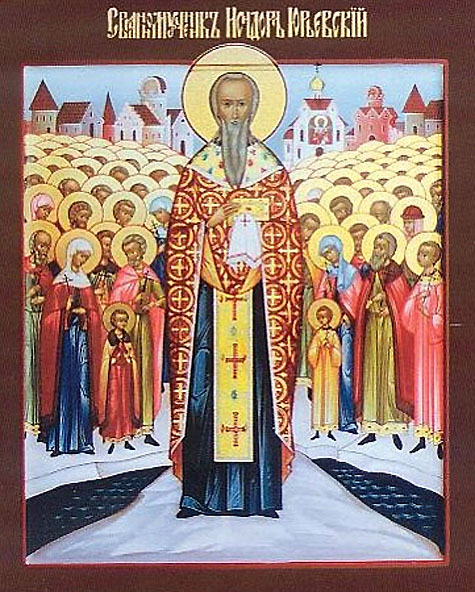 Saint Isidore was priest of St Nicholas church in the city of Yuriev (Derpto, at present Taru in Estonia). According to the terms of a treaty concluded in 1463 between the Moscow Great Prince Ivan III and the Livonian knights, the latter were obligated to extend every protection to the Orthodox at Derpto. But the Livonian knights (who were German Catholics) broke the treaty and tried to force the Orthodox to become Roman Catholics.
The priest Isidore bravely stood forth in defense of Orthodoxy, preferring to accept a martyr’s crown rather than submit to the Catholics. The Latin bishop and the Roman Catholic nobles of Yuriev had been told that St Isidore and the Orthodox population of the city had spoken against the faith and customs of the Germans.
When St Isidore and seventy-two of his parishioners went to bless the waters of the River Omovzha (or Emaiyga, now Emajogi) for the Feast of Theophany, they were arrested and brought before the Latin bishop Andrew and the civil judges of the city. Pressure was brought on them to convert to Catholicism, but the saint and his flock refused to renounce Christ or the Orthodox Faith. Enraged by this, the authorities had them thrown into prison.
St Isidore encouraged his flock to prepare themselves for death, and not to fear torture. He partook of the reserved Gifts he carried with him, then communed all the men, women, and children with the Holy and Life-Giving Mysteries of Christ.
Then the bishop and the judges summoned the Orthodox to appear before them once more, demanding that they convert to Catholicism. When they refused to do so, they were dragged back to the river and pushed through the hole in the ice that they had cut to bless the water. So they all suffered and died for Christ, Who bestowed on them crowns of unfading glory.
During the spring floods, the incorrupt bodies of the holy martyrs, including the fully-vested body of the hieromartyr Isidore, were found by Russian merchants journeying along the river bank. They buried the saints around the church of St Nicholas.
Although people began to venerate these saints shortly after their death, they were not officially glorified by the Church until 1897. Saint Isidore was priest of St Nicholas church in the city of Yuriev (Derpto, at present Taru in Estonia). According to the terms of a treaty concluded in 1463 between the Moscow Great Prince Ivan III and the Livonian knights, the latter were obligated to extend every protection to the Orthodox at Derpto. But the Livonian knights (who were German Catholics) broke the treaty and tried to force the Orthodox to become Roman Catholics.
The priest Isidore bravely stood forth in defense of Orthodoxy, preferring to accept a martyr’s crown rather than submit to the Catholics. The Latin bishop and the Roman Catholic nobles of Yuriev had been told that St Isidore and the Orthodox population of the city had spoken against the faith and customs of the Germans.
When St Isidore and seventy-two of his parishioners went to bless the waters of the River Omovzha (or Emaiyga, now Emajogi) for the Feast of Theophany, they were arrested and brought before the Latin bishop Andrew and the civil judges of the city. Pressure was brought on them to convert to Catholicism, but the saint and his flock refused to renounce Christ or the Orthodox Faith. Enraged by this, the authorities had them thrown into prison.
St Isidore encouraged his flock to prepare themselves for death, and not to fear torture. He partook of the reserved Gifts he carried with him, then communed all the men, women, and children with the Holy and Life-Giving Mysteries of Christ.
Then the bishop and the judges summoned the Orthodox to appear before them once more, demanding that they convert to Catholicism. When they refused to do so, they were dragged back to the river and pushed through the hole in the ice that they had cut to bless the water. So they all suffered and died for Christ, Who bestowed on them crowns of unfading glory.
During the spring floods, the incorrupt bodies of the holy martyrs, including the fully-vested body of the hieromartyr Isidore, were found by Russian merchants journeying along the river bank. They buried the saints around the church of St Nicholas.
Although people began to venerate these saints shortly after their death, they were not officially glorified by the Church until 1897. St. Macarius (Macres) of Vatopedi, Mt. AthosSt. Theodore of Constantinople
|